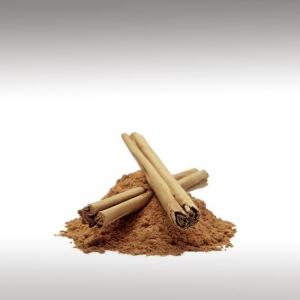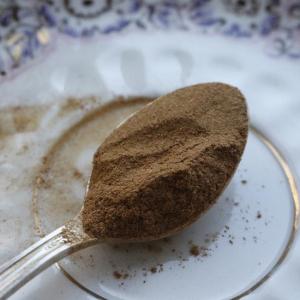
GROUND CEYLON CINNAMON (CINNAMOMUM ZEYLANICUM) - INGREDIENTS

BASE / GENERAL DATA
Information submited: June 17, 2015 Modified: May 30, 2018 By: OperaDreamhouse
Cinnamon is a spice obtained from the inner bark of several trees from the genus Cinnamomum. Cinnamon is the name for perhaps a dozen species of trees and the commercial spice products that some of them produce. All are members of the genus Cinnamomum in the family Lauraceae.
The English word Cinnamon, attested in English since the 15th century, derives from the Greek Kinnámōmon (later Kínnamon), via Latin and medieval French intermediate forms. The Greek in turn was borrowed from a Phoenician word, which would have been akin to the related Hebrew Qinnamon.
Though its source was kept mysterious in the Mediterranean world for centuries by the middlemen who handled the spice trade, to protect their monopoly as suppliers, Cinnamon is native to Bangladesh, Sri Lanka, the Malabar Coast of India, and Burma.
The old botanical synonym for the tree - Cinnamomum Zeylanicum - is derived from Sri Lanka's former name, Ceylon. Sri Lanka still produces 80 - 90% of the world's supply of Cinnamomum Verum, and it is also cultivated on a commercial scale in Seychelles and Madagascar.
Cinnamomum Verum (Cinnamomum Zeylanicum), called "True Cinnamon tree" or Ceylon Cinnamon tree is a small evergreen tree, native to Sri Lanka. Among other species, its inner bark is used to make Cinnamon.
Cinnamon was so highly prized among ancient nations that it was regarded as a gift fit for monarchs and even for a god.
Indonesian rafts transported cinnamon directly from the Moluccas to East Africa , where local traders then carried it north to Alexandria in Egypt. Venetian traders from Italy held a monopoly on the spice trade in Europe, distributing cinnamon from Alexandria. The disruption of this trade by the rise of other Mediterranean powers, such as the Mamluk sultans and the Ottoman Empire, was one of many factors that led Europeans to search more widely for other routes to Asia.
When Portuguese traders landed in Ceylon (Sri Lanka), they restructured the traditional production and management of cinnamon by the Sinhalese. They established a fort on the island in 1518 and protected Ceylon as their cinnamon monopoly for over a hundred years. Later, Sinhalese held the monopoly for Cinnamon in Ceylon.
Now Sri Lanka produces 80 - 90% of the world's supply of Cinnamomum Verum, but that is the only species grown there. Cinnamomum verum is also cultivated on a commercial scale in Seychelles and Madagascar.
Sri Lanka Cinnamon has a very thin, smooth bark with a light - yellowish brown colour and a highly fragrant aroma.
CeylonCcinnamon, using only the thin inner bark, has a lighter brown colour, a finer, less dense and more crumbly texture, and is considered to be subtler and more aromatic in flavour than cassia (Cinnamomum cassia), losing much of its flavour during cooking. Ceylon Cinnamon sticks (quills) have many thin layers and can easily be made into powder using a coffee or spice grinder, whereas Cassia sticks are much harder.
In the case of stick Cinnamon there are also certain features of the sticks you might want to look for in order to determine whether your Cinnamon is Ceylon Cinnamon or Cassia Cinnamon. One of those features involves the texture of the sticks when you look downward at a stick so that you can see the end.
When Cinnamon sticks are rolled from the thick bark of the Cassia plants, they look exactly as described - a one - piece, thick bark layer that does not show multiple layers of any kind. In the case of Ceylon Cinnamon sticks, since the plant bark is thinner, you may be able to see multiple layers of a thinner bark. That thinner layering of bark is one indication that your Cinnamon sticks are made from Ceylon Cinnamon.
Another feature is the typically darker and deeper reddish color shade of Ceylon Cinnamon sticks. Finally, the thicker and harder bark of Cassia - type cinnamon sticks often prevents them from having small pieces that have broken off, where Ceylon Cinnamon is more fragile and easily broken.
The English word Cinnamon, attested in English since the 15th century, derives from the Greek Kinnámōmon (later Kínnamon), via Latin and medieval French intermediate forms. The Greek in turn was borrowed from a Phoenician word, which would have been akin to the related Hebrew Qinnamon.
Though its source was kept mysterious in the Mediterranean world for centuries by the middlemen who handled the spice trade, to protect their monopoly as suppliers, Cinnamon is native to Bangladesh, Sri Lanka, the Malabar Coast of India, and Burma.
The old botanical synonym for the tree - Cinnamomum Zeylanicum - is derived from Sri Lanka's former name, Ceylon. Sri Lanka still produces 80 - 90% of the world's supply of Cinnamomum Verum, and it is also cultivated on a commercial scale in Seychelles and Madagascar.
Cinnamomum Verum (Cinnamomum Zeylanicum), called "True Cinnamon tree" or Ceylon Cinnamon tree is a small evergreen tree, native to Sri Lanka. Among other species, its inner bark is used to make Cinnamon.
Cinnamon was so highly prized among ancient nations that it was regarded as a gift fit for monarchs and even for a god.
Indonesian rafts transported cinnamon directly from the Moluccas to East Africa , where local traders then carried it north to Alexandria in Egypt. Venetian traders from Italy held a monopoly on the spice trade in Europe, distributing cinnamon from Alexandria. The disruption of this trade by the rise of other Mediterranean powers, such as the Mamluk sultans and the Ottoman Empire, was one of many factors that led Europeans to search more widely for other routes to Asia.
When Portuguese traders landed in Ceylon (Sri Lanka), they restructured the traditional production and management of cinnamon by the Sinhalese. They established a fort on the island in 1518 and protected Ceylon as their cinnamon monopoly for over a hundred years. Later, Sinhalese held the monopoly for Cinnamon in Ceylon.
Now Sri Lanka produces 80 - 90% of the world's supply of Cinnamomum Verum, but that is the only species grown there. Cinnamomum verum is also cultivated on a commercial scale in Seychelles and Madagascar.
Sri Lanka Cinnamon has a very thin, smooth bark with a light - yellowish brown colour and a highly fragrant aroma.
CeylonCcinnamon, using only the thin inner bark, has a lighter brown colour, a finer, less dense and more crumbly texture, and is considered to be subtler and more aromatic in flavour than cassia (Cinnamomum cassia), losing much of its flavour during cooking. Ceylon Cinnamon sticks (quills) have many thin layers and can easily be made into powder using a coffee or spice grinder, whereas Cassia sticks are much harder.
In the case of stick Cinnamon there are also certain features of the sticks you might want to look for in order to determine whether your Cinnamon is Ceylon Cinnamon or Cassia Cinnamon. One of those features involves the texture of the sticks when you look downward at a stick so that you can see the end.
When Cinnamon sticks are rolled from the thick bark of the Cassia plants, they look exactly as described - a one - piece, thick bark layer that does not show multiple layers of any kind. In the case of Ceylon Cinnamon sticks, since the plant bark is thinner, you may be able to see multiple layers of a thinner bark. That thinner layering of bark is one indication that your Cinnamon sticks are made from Ceylon Cinnamon.
Another feature is the typically darker and deeper reddish color shade of Ceylon Cinnamon sticks. Finally, the thicker and harder bark of Cassia - type cinnamon sticks often prevents them from having small pieces that have broken off, where Ceylon Cinnamon is more fragile and easily broken.

SPIRITUAL PRACTISES DATA

MEDICINE / HEALTH DATA

BEAUTY / COSMETICS DATA

FOOD / COOKING DATA
COMMENTS
No comments.
Newest mixtures containing Ground Ceylon Cinnamon (Cinnamomum Zeylanicum):

Immune system booster (suitable for II - type of diabetes)
June 17, 2015



